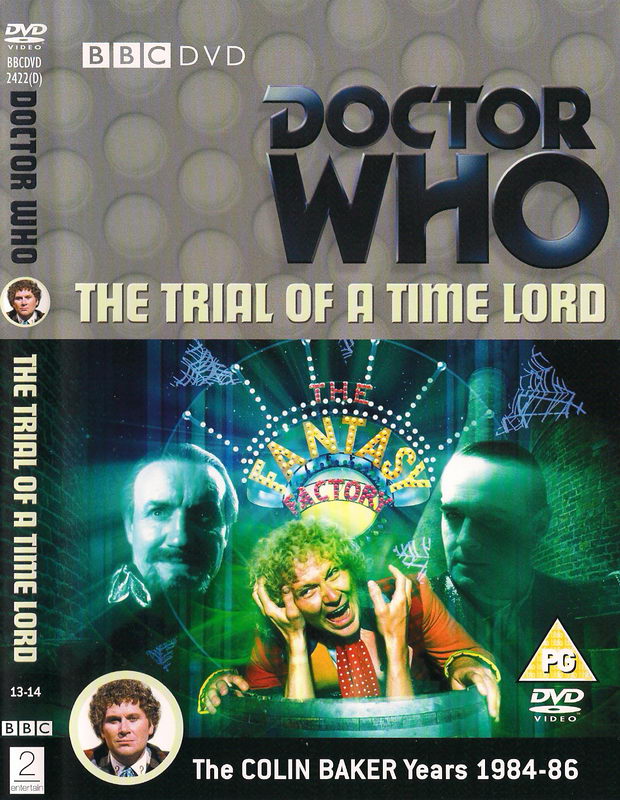
Aired 29 November – 6 December 1986
It’s fair to say that the entire The Trial of a Time Lord arc is somewhat muddled in its execution. Following an eighteen-month hiatus during which the prospect of Doctor Who’s viability was tenuous at best, the proposition of putting the Doctor on trial to prove how strong both he and, by extension, Doctor Who remained was a tremendously intriguing and brave one. However, with three opening serials ranging from decent to fairly terrible and the Doctor’s characterization suffering immensely under an air of ambiguity due to Matrix tampering, it’s hard to believe that this arc was the best that could be achieved with the extra time and reduced episode order afforded. Perhaps more than in most arcs, then, it is up to the conclusion to provide a sort of finality that puts everything that has come before it into meaningful context and achieves what the original intent clearly was. Unfortunately, the passing of Robert Holmes before his completion of the final script threw yet another unexpected hurdle in the way of the production, and writers Pip and Jane Baker- without being allowed to know how the story was supposed to end- are simply unable to finish what was started and offer a satisfyingly deep conclusion that proves the future is in safe hands.
Accordingly, ‘The Ultimate Foe’ is very much a story of two halves, and it’s quite satisfying, whether intended or not, that the Valeyard’s true identity being a shadowy manifestation of the Doctor between his penultimate and final regeneration highlights a show at war with itself amidst outsiders’ love for its past and continued mounting pressure. More explicitly, this pits the Doctor against himself, and the fact that he remains unable to mount a compelling defense for himself speaks volumes about the state of the show and its writers. It seems like the Valeyard was being built up to be an altogether different sort of threat for the Doctor given the very personal relationship the two share, but the finale provided instead treats him simply as another generic foe much in line with the Master who also appears here. It’s clear that the Valeyard is after more than simply the Doctor’s remaining regenerations, regeneration cycles being something that Time Lords have the ability to reward, but any hidden motivations for this farce of a trial are sadly never explained. At the very least, it seems quite poignant that the Valeyard within the beauracracy of his Matrix sees fit to bring out homages to several classic Doctor Who sequences before seeing the ground give out underneath the Doctor, a fitting bit of symbolism for the programme’s perceived downward trajectory since deciding to look more to past continuity than to unique individualism.
Aside from the many intriguing intimations about the Valeyard that are dropped in the second part, ‘The Ultimate Foe’ is notable for not actually resolving anything after fourteen episodes of promise. The trial is suspended and the Doctor never really gets to prove himself against the Valeyard’s more damning charges, especially that of genocide. Of course, it does manage to call just about all of ‘Mindwarp’ into question and, in doing so, eliminates much of the powerful resonance that emanated from Peri’s death in that serial without properly explaining how the alternate reality shown truly came to be and under what terms the Doctor and she parted company. It seems quite obvious that the out-of-sequence introduction of Mel without any real backstory to speak of was intended to be a stark contrast to Peri and her implied history of abuse, but not explaining how Peri chose to be with a man she seemed to have little affinity for in ‘Mindwarp’ further undermines a character who had been improperly written since the start.
The first half of ‘The Ultimate Foe’ shows a lot of promise as the murkiness of the Valeyard is slowly revealed and symbolism is excellently employed, but the second half is ultimately just a limp to the end of the season that fails to capitalize on that potential, to build on anything from the previous three serials, or to offer a satisfying resolution to assuage doubts about the future. Much as The Trial of a Time Lord itself is hardly the perfect defense for the Doctor or Doctor Who, ‘The Ultimate Foe’ is hardly the impactful finale needed for a fourteen-episode arc.


Episode 14 was the result of background politics and antagonism between Eric Saward and JNT. Robert Holmes withdrew his script after seeing what they did to the first story, Eric Saward under a lot of pressure then wrote the 2-parter wotha clifffhanger ending that had the Doctor and the Valyard fighting for eternity in the Matrix, forever trapped. JNY objected to this, so it was up to the ‘superteam’ (yes, this is sarcasm) of Pip and Jane Baker to come uo with the happy ending. Fortunately, JNT nixed the dancing girls at the last minute. Politicsm bullying and sheer bloody mindedness gave us that limp ending